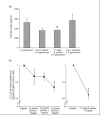Modulation of pathogen-induced CCL20 secretion from HT-29 human intestinal epithelial cells by commensal bacteria
- PMID: 19814810
- PMCID: PMC2763856
- DOI: 10.1186/1471-2172-10-54
Modulation of pathogen-induced CCL20 secretion from HT-29 human intestinal epithelial cells by commensal bacteria
Abstract
Background: Human intestinal epithelial cells (IECs) secrete the chemokine CCL20 in response to infection by various enteropathogenic bacteria or exposure to bacterial flagellin. CCL20 recruits immature dendritic cells and lymphocytes to target sites. Here we investigated IEC responses to various pathogenic and commensal bacteria as well as the modulatory effects of commensal bacteria on pathogen-induced CCL20 secretion. HT-29 human IECs were incubated with commensal bacteria (Bifidobacterium infantis or Lactobacillus salivarius), or with Salmonella typhimurium, its flagellin, Clostridium difficile, Mycobacterium paratuberculosis, or Mycobacterium smegmatis for varying times. In some studies, HT-29 cells were pre-treated with a commensal strain for 2 hr prior to infection or flagellin stimulation. CCL20 and interleukin (IL)-8 secretion and nuclear factor (NF)-kappaB activation were measured using enzyme-linked immunosorbent assays.
Results: Compared to untreated cells, S. typhimurium, C. difficile, M. paratuberculosis, and flagellin activated NF-kappaB and stimulated significant secretion of CCL20 and IL-8 by HT-29 cells. Conversely, B. infantis, L. salivarius or M. smegmatis did not activate NF-kappaB or augment CCL20 or IL-8 production. Treatment with B. infantis, but not L. salivarius, dose-dependently inhibited the baseline secretion of CCL20. In cells pre-treated with B. infantis, C. difficile-, S. typhimurium-, and flagellin-induced CCL20 were significantly attenuated. B. infantis did not limit M. Paratuberculosis-induced CCL20 secretion.
Conclusion: This study is the first to demonstrate that a commensal strain can attenuate CCL20 secretion in HT-29 IECs. Collectively, the data indicate that M. paratuberculosis may mediate mucosal damage and that B. infantis can exert immunomodulatory effects on IECs that mediate host responses to flagellin and flagellated enteric pathogens.
Figures






Similar articles
-
Functional modulation of human intestinal epithelial cell responses by Bifidobacterium infantis and Lactobacillus salivarius.Immunology. 2006 Jun;118(2):202-15. doi: 10.1111/j.1365-2567.2006.02358.x. Immunology. 2006. PMID: 16771855 Free PMC article.
-
In vitro and ex vivo activation of the TLR5 signaling pathway in intestinal epithelial cells by a commensal Escherichia coli strain.J Biol Chem. 2004 Oct 8;279(41):42984-92. doi: 10.1074/jbc.M405410200. Epub 2004 Aug 9. J Biol Chem. 2004. PMID: 15302888
-
Clostridium difficile flagellin stimulates toll-like receptor 5, and toxin B promotes flagellin-induced chemokine production via TLR5.Life Sci. 2013 Feb 27;92(3):211-7. doi: 10.1016/j.lfs.2012.11.017. Epub 2012 Dec 19. Life Sci. 2013. PMID: 23261530
-
Development, validation and implementation of an in vitro model for the study of metabolic and immune function in normal and inflamed human colonic epithelium.Dan Med J. 2015 Jan;62(1):B4973. Dan Med J. 2015. PMID: 25557335 Review.
-
Epithelial barrier: an interface for the cross-communication between gut flora and immune system.Immunol Rev. 2012 Jan;245(1):147-63. doi: 10.1111/j.1600-065X.2011.01078.x. Immunol Rev. 2012. PMID: 22168418 Review.
Cited by
-
TLR1-induced chemokine production is critical for mucosal immunity against Yersinia enterocolitica.Mucosal Immunol. 2013 Nov;6(6):1101-9. doi: 10.1038/mi.2013.5. Epub 2013 Feb 27. Mucosal Immunol. 2013. PMID: 23443468 Free PMC article.
-
The role of peroxisome proliferator-activated receptor γ in immune responses to enteroaggregative Escherichia coli infection.PLoS One. 2013;8(2):e57812. doi: 10.1371/journal.pone.0057812. Epub 2013 Feb 28. PLoS One. 2013. PMID: 23469071 Free PMC article.
-
Oral Administration of Lactobacillus rhamnosus GG Ameliorates Salmonella Infantis-Induced Inflammation in a Pig Model via Activation of the IL-22BP/IL-22/STAT3 Pathway.Front Cell Infect Microbiol. 2017 Jul 18;7:323. doi: 10.3389/fcimb.2017.00323. eCollection 2017. Front Cell Infect Microbiol. 2017. PMID: 28770173 Free PMC article.
-
Current challenges facing the assessment of the allergenic capacity of food allergens in animal models.Clin Transl Allergy. 2016 Jun 16;6:21. doi: 10.1186/s13601-016-0110-2. eCollection 2016. Clin Transl Allergy. 2016. PMID: 27313841 Free PMC article. Review.
-
Immunomodulation for gastrointestinal infections.Expert Rev Anti Infect Ther. 2012 Mar;10(3):391-400. doi: 10.1586/eri.11.176. Expert Rev Anti Infect Ther. 2012. PMID: 22397571 Free PMC article. Review.
References
Publication types
MeSH terms
Substances
LinkOut - more resources
Full Text Sources
Other Literature Sources
Medical

